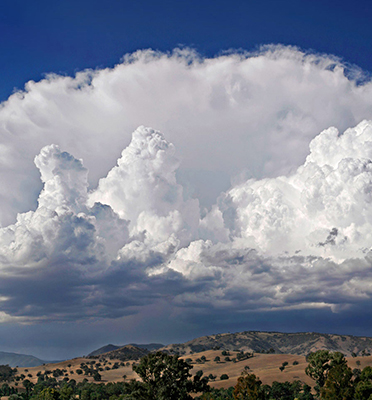Atmospher Sci & Global Chg
Research Highlights
May 2017
Cloud Brightness: Enlightening Pollution's Influence
Researchers found hope for understanding the relationship between clouds and atmospheric particles by peering into the past

Clouds' Past and Future Researchers delved into cloud past and present-day brightening to understand how they affect the warming and cooling of the Earth. How clouds have changed since the dawn of the industrial age offer hope to project the future impact of clouds on the Earth’s energy balance.
Scientists are using virtual time travel to unravel mysteries about clouds, pollution, and the future effects of both on the climate. Researchers at Pacific Northwest National Laboratory teamed with the Imperial College in London and other institutions across the globe to better understand the relationship between changes in clouds and fine atmospheric particles called aerosols from pre-industrial to present-day conditions.
The data compiled allowed the team to reveal the difference in particle size versus particle type, thus determining the human impact effect on clouds during present-day more accurately. The research, showing better information leads to better future predictions, was published in The Proceedings of the National Academy of Sciences.
Why it Matters: Brighter clouds reflect and diffuse more of the incoming sunlight, creating a local cooling effect. While human activities are helping warm the planet by producing more greenhouse gases, much of that combustion can also produce more tiny particles that water vapor condenses on and brightens clouds. Knowing how to gauge the amount of cooling and warming triggered by modified clouds in the past compared to the present will forward understanding about what the future may hold under various conditions.
Methods: Clouds tend to be brighter when there are more particles for droplets to form around, so the researchers compiled statistical graphs showing the distribution of cloud droplet numbers in today's clouds based on satellite data. An additional piece of the puzzle was understaning the kinds of emissions present in pre-industrial times and running models to gauge the cloud brightness of the past.
The team formed joint histograms—statistical representations of distributions—of droplet number/aerosol number from global model simulations for pre-industrial and present-day aerosol emissions. They found little difference between the histograms for past and present emissions, and found that the impact of the human-caused emissions change on droplet number could be accurately estimated from the present-day histogram and the change in the aerosol. This suggests the present-day relationship between droplet number and aerosol number can guide understanding of the estimated impact of human-caused particle emissions on cloud droplet number.
What's Next? Clouds continue to be one of the biggest challenges for climate modeling and future projections. Scientists will continue to tackle cloud mysteries to unlock more secrets of the past and future.
For more information, read the PNNL news brief, "Cloud brightness enlightens effects of pollution" and the Imperial College of London's news release, "Clouds' response to pollution clarified with new climate analysis."
Acknowledgements
Sponsors: The PNNL researchers were supported by the Department of Energy Office of Science Biological and Environmental Research for the Decadal and Regional Climate Prediction using Earth System Models (EaSM) program supported by the Regional and Global Climate Modeling program; and the Earth System Modeling program. Additional funding was provided by the European Research Council, the Natural Environment Research Council, the Austrian Science Fund, the Environment Research and Technology Development Fund of Japan, the Japan Society for the Promotion of Science, the National Natural Science Foundation of China, the Swiss National Supercomputing Center, and the National Institute for Environmental Studies in Japan.
Research Team: Steve Ghan, Hailong Wang, and Kai Zhang, PNNL; Minghuai Wang (formerly of PNNL); Edward Gryspeerdt and Johannes Quaas, University of Leipzig Germany; Sylvaine Ferrachat, Ulrike Lohmann, and David Neubauer, Institute for Atmospheric and Climate Science, Zurich, Switzerland; Andrew Gettelman, and Hugh Morrison, National Center for Atmospheric Research; Daniel G. Partridge, Stockholm University; Philip Stier, University of Oxford, UK; and Toshihiko Takemura, Kyushu University, Japan.
Research Area: Climate and Earth Systems Science
Reference: Gryspeerdt E, J Quaas, S Ferrachat, A Gettelman, S Ghan, U Lohmann, H Morrison, D Neubauer, DG Partridge, P Stier, T Takemura, H Wang, M Wang, and K Zhang. 2017. "Constraining the Instantaneous Aerosol Influence on Cloud Albedo." Proceedings of the National Academy of Sciences 114(19):4899-4904. DOI: 10.1073/pnas.1617765114
